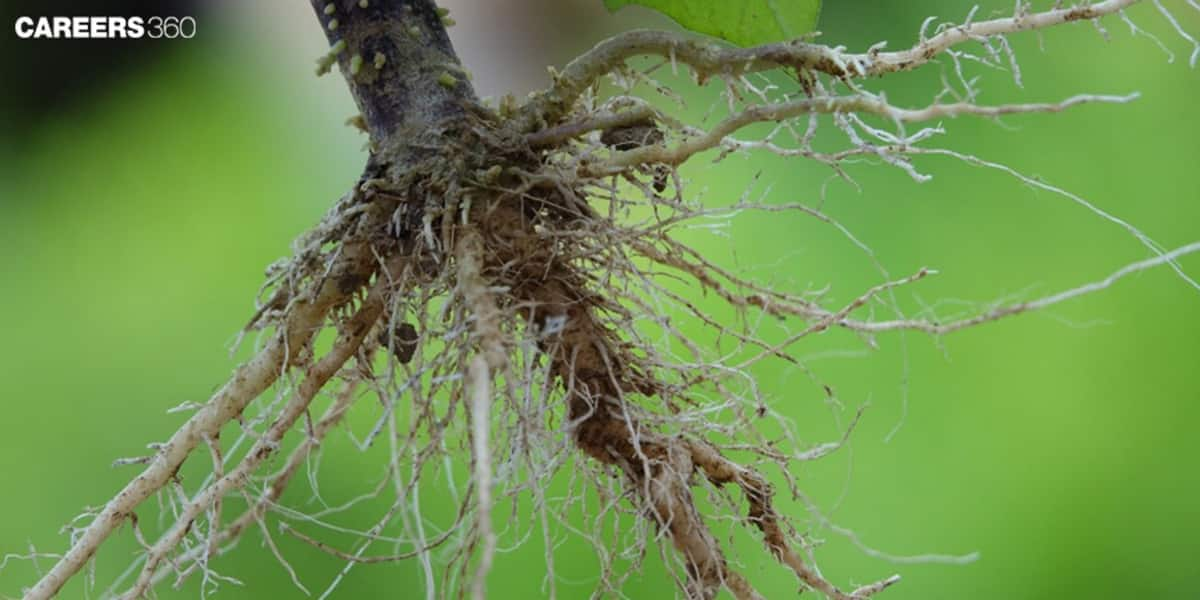Mycorrhizae: An Overview
Definition - Mycorrhiza is a mutualistic or symbiotic relationship of fungi with roots of higher plants. The fungus helps the plant absorb water and essential nutrients (like phosphorus) from the soil, while the plant provides the fungus with carbohydrates produced through photosynthesis. This mutualistic relationship improves plant growth and soil health. Mycorrhizae is a topic of the chapter Biological Classification in Biology.
NEET 2025: Mock Test Series | Syllabus | High Scoring Topics | PYQs
NEET Important PYQ's Subject wise: Physics | Chemistry | Biology
New: Meet Careers360 B.Tech/NEET Experts in your City | Book your Seat now
- What is Mycorrhiza? - Meaning
- Types of Mycorrhiza
- Mechanism Of Mycorrhizal Symbiosis
- Mycorrhizae Examples
- Mycorrhizae - Functions And Benefits
- Environmental Impact
- Recommended video for Mycorrhizae

What is Mycorrhiza? - Meaning
Mycorrhizae is very important in the biological functioning of plants as they form mutually beneficial relationships where the fungi beneficially derive carbon from the plant and on the other hand the plant benefits from the conversion of nitrogen and phosphorus by the fungi.
The two groups are ectomycorrhizae which form sheaths around the tips of roots of trees and shrubs and endomycorrhizae or arbuscular mycorrhizae which penetrate the cells of roots of the host plants and are useful for many kinds of crops. Awareness of mycorrhiza is crucial in matters of sustainable system agriculture and healthy ecosystems because of the services that they provide such as promoting plant growth and nutrition, the cycling of nutrients, and the efficiency of plant stress.
Types of Mycorrhiza
The types of mycorrhizae are listed below-
Ectomycorrhizae
Ectomycorrhiza has thick fungal tubes in the region of tips of the plant roots without penetrating cell walls and increasing the transport of nutrients.
Examples of fungi are Amanita, Boletus, and Tricholoma and they are mycorrhizal fungi associated with pines, oaks or birch respectively.
These mycorrhizae are frequent in temperate and boreal forests and help many valuable trees by amending their capability to take up mineral nutrients and resist pathogens.
Endo mycorrhizae (Arbuscular Mycorrhizae)
Endomycorrhizae invades the cells of plant roots with its hyphae and the structures developed by it which are arbuscules and vesicles.
They help in the translocation of nutrients between the fungi and plant through the fungi giving the plant phosphorus, nitrogen and other minerals in return for carbohydrates from the host plant.
Some of the host plants in arbuscular mycorrhizal association include the major agriculture crops like wheat, maize, and soybean and pulses like beans and peas. These mycorrhizae are also commonly found in natural plant environments and help herbaceous as well as woody plants in nutrient absorption and are helpful in areas of drought tolerance.

Also read-
Mechanism Of Mycorrhizal Symbiosis
The mechanism is described below-
Initiation of Symbiosis
The process starts with the activation of fungal spores, which start germinating near the roots of the plant due to chemical signals from the roots. This marks the commencement of the formation of hyphal structures which in this case, will grow towards the surface of the roots.
Fungal Hyphae Penetration into Roots
The fungal hyphae invade the outer epidermis of the plant root cells and establish themselves as a friendly body without the awareness of the plant's defence mechanism. This penetration is made possible by the secretion of enzymes by the fungi which act to weaken the cell wall.
Formation Of Symbiotic Structures
In the root cells of the host plant, the arbuscular mycorrhiza develops highly branched structures known as arbuscules, which bear a resemblance to trees Nguyen and Lucoo 2008. In ectomycorrhizae, there is an interfacial Hartig net between the hyphal network and the outer cred of the root cells for nutrient exchange. Such structures are fundamental in the transport of nutrients between the fungus and the plant improving the nutrient ranking from the soil, water, and minerals.
Mycorrhizae Examples
Some examples of mycorrhizal associations:
Arbuscular Mycorrhiza: These are typical for most crops like wheat, rice, and maize where Glomeromycota fungi are well known to form arbuscules in the form of a tree-like structure inside the root cell to exchange nutrients.
Ectomycorrhiza: In general, these are found in trees such as pine, oak, and eucalyptus, whereas here, fungi of the types Amanita, Boletus, and Tricholoma form a sheath around the roots, which help absorb water and nutrients.
Ericoid Mycorrhiza: This occurs on plants belonging to the Ericaceae family like blueberry and rhododendron. In such poor nutrient content and acidic soils, fungi like Oidiodendron enable the plants to survive.
Orchid Mycorrhiza: This is a condition which orchids cannot be without, it occurs since their seed germination requires fungi belonging to the genus Rhizoctonia. The seed germination in the case of orchids is slow due to the fact that the nutrients are yet to be developed in the initial growth stages.
Mycorrhizae - Functions And Benefits
The function and benefits of mycorrhizae are listed below-
Nutrient Exchange
Role In Phosphorus Uptake
The mycorrhizal fungi play a vital role in increasing the ability of plants in the uptake of phosphorus especially where phosphorus is least available in the soil. It is well understood that fungal hyphae penetrate deeply into the soil beyond the root region to acquire phosphorus that is out of reach by the roots of the plant.
Nitrogen and micronutrient acquisition
In addition to phosphorus, the mycorrhizal symbiosis increases nitrogen and micronutrients like zinc, copper, and iron in the plant. The intervened fungi obtain and transform these nutrients in the soil into forms that can be absorbed by the plant roots.
Enhancement of plant growth and development
Through the mechanisms of nutrient acquisition, mycorrhizal associations thus positively affect root growth and plant development. This comprises raised biomass, improved root system, efficient water uptake and utilization, and improved stress tolerance including water stress and salty soils.
Enhanced Water Absorption
Contribution to drought tolerance
Mycorrhizal fungi help the plants to be drought-resistant by expanding the roots to areas where there are Watery soles. Such a large network assists plants in continuing their various functions even when they lack water.
Regulation of water movement
How these light fungi contribute to plant life and why they spread so easily, easy penetration into plant tissues allows for better water transport and distribution. This regulation aids plant health and their condition concerning findings of soil moisture, which in a way enhances plant growth and production.
Pathogen Protection
Mechanisms against pathogens
Some functions are pursued by mycorrhizal fungi to withstand pathogen infestation They can easily outcompete even the pathogens for space and nutrients in the rhizosphere thereby reducing colonization of plant roots by the pathogens. Also, certain mycorrhizal fungi synthesise antibiosis or secondary metabolites that slow down or stop the growth of the pathogen.
Induction of plant defence responses
Mycorrhizal symbiosis is capable of eliciting the plants’ defence reactions, thus putting the plant on alert against pathogens. This involves the activation of systemic resistance mechanisms for example through the synthesis of pathogenesis-related proteins and phytoalexins. It aids plants in preventing infection and limiting the impact of diseases on them.
Environmental Impact
The environmental impact of mycorrhizal is discussed below-
Contribution To Ecosystem Diversity
The mycorrhizal fungi are equally instrumental in increasing the earth's ecosystem’s diversity more so via its mutualistic association with most plant species. These associations help nurture and sustain the existence of diverse types of plant life ranging from forest to grassland ecosystems hence boosting the issue of diversity.
Role In Soil Structure And Health
Mycorrhizal fungi are involved in the formation of extraradical hyphae that enhance the physical characteristics of the soil including aggregation and stability. They also reduce the availability of nutrients, and recycle organic matter with variations from, and uptake by plants; this increases the fertility and productivity of the soil.
Adaptation To Environmental Stressors
Auxiliary mycorrhizal symbiosis is useful in climate stress clients including drought, salinity and pollution. Mycorrhizal fungi enhance the nutrient and water relations of the plants as they help the plants to survive under many conditions. They also make the plant resistant to diseases/pests hence helping in the ecological balance and reliability.
Also Read-
| Cell Envelope | Five Kingdom Classification |
| Composition of Bacterial Cell Wall | Kingdom Monera, Protista And Fungi |
| Gram Staining | Salient features of the Kingdom Monera |
Recommended video for Mycorrhizae
Frequently Asked Questions (FAQs)
Mycorrhizae are a mutual connection between fungi and roots of the host plant that helps the plant to absorb higher nutrients especially phosphorous, nitrogen and water in addition to helping the plant to grow and become resistant to harsh conditions in the environment like drought.
It is noted that mycorrhizae spread their fungal hyphae into the root zone of a plant and draw nutrients like phosphorus and micronutrients in exchange for carbon compounds supplied by the plants. This mutualism assumes a favourable exchange that greatly improves the efficiency with which the plants can absorb the nutrients.
Ectomycorrhizal fungi occur with trees of pines, oaks, and birch, while arbuscular mycorrhizal fungi do so with agronomical crops like wheat, maize, and legumes. They enhance the efficiency by which nutrients are acquired and enhance plant fitness.
Yes, mycorrhizae can guard plants against diseases by stimulating the plant to produce compounds which defend it and tending to use up the resources and spaces that pathogens require around the plant roots.
Yes, mycorrhizae are useful to agriculture because they improve the structure and fertility of the soil as well as water and nutrient absorption in crops. Since they minimize the use of chemical fertilizers, they encourage organic farming and help instil ecological integrity in the agricultural systems.
Also Read
30 Nov'24 12:23 PM
28 Nov'24 05:34 PM
25 Nov'24 05:18 PM
23 Nov'24 10:02 AM
22 Nov'24 01:59 PM
21 Nov'24 04:58 PM
16 Nov'24 01:58 PM
